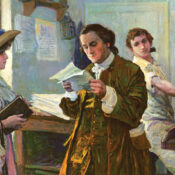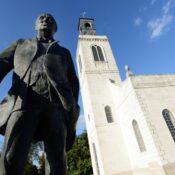It’s not unusual for a character from novels and short stories to make the jump to film or television. In fact, so-called transmedia properties are extremely common today, with comics designed to be films or TV shows that get adapted into long-running series of books. However, it’s not every day that a character crosses over, and brings an entire genre with them. That was the case on June 24, 1949, when Hopalong Cassidy made the jump from books and movies to the small screen, kicking off the legacy of the Western on television.
Hopalong wasn’t new in 1949. The character first appeared in the writings of Clarence E. Mulford. He created the character in 1904, and the first book to feature Hopalong, Bar-20, saw publication in 1906. The original version of Hopalong was considerably more of a rude character than he would be onscreen; he also owed his nickname to a wooden leg. By the time that he became the title character of 1910’s Hopalong Cassidy, the cowboy already had a strong following.
Some of Cassidy’s rougher edges where smoothed when he made the transition to the big screen in 1935. Actor William Boyd took on the role, and the character became a bastion of fair play. Perhaps as a nod to his more dangerous literary persona, Cassidy (who earned his nickname from a gunshot-induced limp rather that a wooden leg) wore all black, including his hat, a departure when most good guys were clad in light colors and white hats. The first film, Hop-Along Cassidy (the inexplicable hyphen was dropped later), took elements from the books but wasn’t a slavish adaptation. Boyd would play Cassidy an astonishing 66 times between 1935 and 1948, with ten different sidekicks accompanying him throughout the films.
Producer Harry Sherman had grown tired of the films by 1944. Boyd took the unusually step of buying the right to the character from Mulford and the previously produced films from Sherman. By 1948, Boyd had a new idea. He took the films to NBC for broadcast; 52 of the movies were edited down to episode length for a Hopalong Cassidy TV series. The first episode, “Sunset Trail,” ran on June 24, 1949.
The young medium proved to be a perfect fit for Boyd and his character. Cassidy’s popularity went through the roof, with the show beloved by kids and adults alike. The remaining 12 films were edited for a second season, and Boyd put together a company to make new episodes (which also featured Edgar Buchanan as new sidekick Red Connors). The edited movies comprised the first two seasons, and the 40 new shows completed two more seasons through 1955. During that same period, Boyd starred in a radio drama version of the show that ran for 105 installments. With the films, TV, and radio (as well as an ongoing comic strip) behind him, Boyd became a massive celebrity, covered by magazines and touring the world.
When he finally retired in his sixties after 20 years of playing the character, Boyd’s primary reluctance at saying good-bye to the show was the employment of his production team and crew. By a stroke of luck, CBS was putting together the TV adaptation of another popular Western radio program. Boyd kept his crew employed by putting them to work at CBS on the new show. It was called Gunsmoke, and it would run for 20 years.
Hopalong Cassidy presaged the dominance that Westerns would display at both the movies and on television throughout the 1950s. While many of the early shows, like Cassidy, were child-friendly, Gunsmoke and its immediate prime-time antecedent, The Life and Legend of Wyatt Earp, were directed at more adult audiences. Those programs led a Western expansion that saw more than 30 of the shows on the air by the end of the decade, with eight of the top ten shows in March of 1959 being Westerns. In the theaters, approximately 700 Westerns were released between 1950 and 1959.
Critics and scholars continue to debate what caused the decline of the Western. While the form was still popular in the 1960s, it wasn’t as pervasive. Pressure groups decried the violence present in some Westerns, while others were affected by general fatigue with the genre. The Space Race kicked off an interest in science fiction programming that, coupled with the rise of color TV, saw “space shows” replace “horse shows.” There was also a shift in the 1960s to programs set in both urban settings and contemporary times, both of which left the Western behind.
The Western itself has never completely left television, and it likely never will. Today, programs like Kevin Costner’s Yellowstone still run on outlets like the Paramount Network, while the general influence of the Western is seen in a variety of diverse 2000s shows like Justified, Hell on Wheels, and the genre-bending science-fiction of Westworld. The general appeal of the genre has never been in question; it relies on the idea of open ranges, the possibility of a bright future, and the notion that the proper person riding in on a good horse can make things right. The dream of the West might be a dream, but at least it’s a good one.
Become a Saturday Evening Post member and enjoy unlimited access. Subscribe now



Comments
William Boyd’s Hopalong Cassidy outfit was actually a dark blue shirt and trousers, but because the movies and television episodes were filmed in black & white no one knew he was dressed in blue. (His hat was black.)
I was nearly 7 before my parents bought a television set in 1950, and I do remember the whole family (only six of us at that time) huddled around a TV screen that couldn’t have been much more than 10″, practically dwarfed by the big wooden cabinet. Hopalong Cassidy was a favorite show to watch, and I think even at that young age, I had a crush on Hoppy! He was a hero for us all to look up to, to emulate in strength and kindness, to know that there were good people in the world. We all loved the Hopalong Cassidy show.